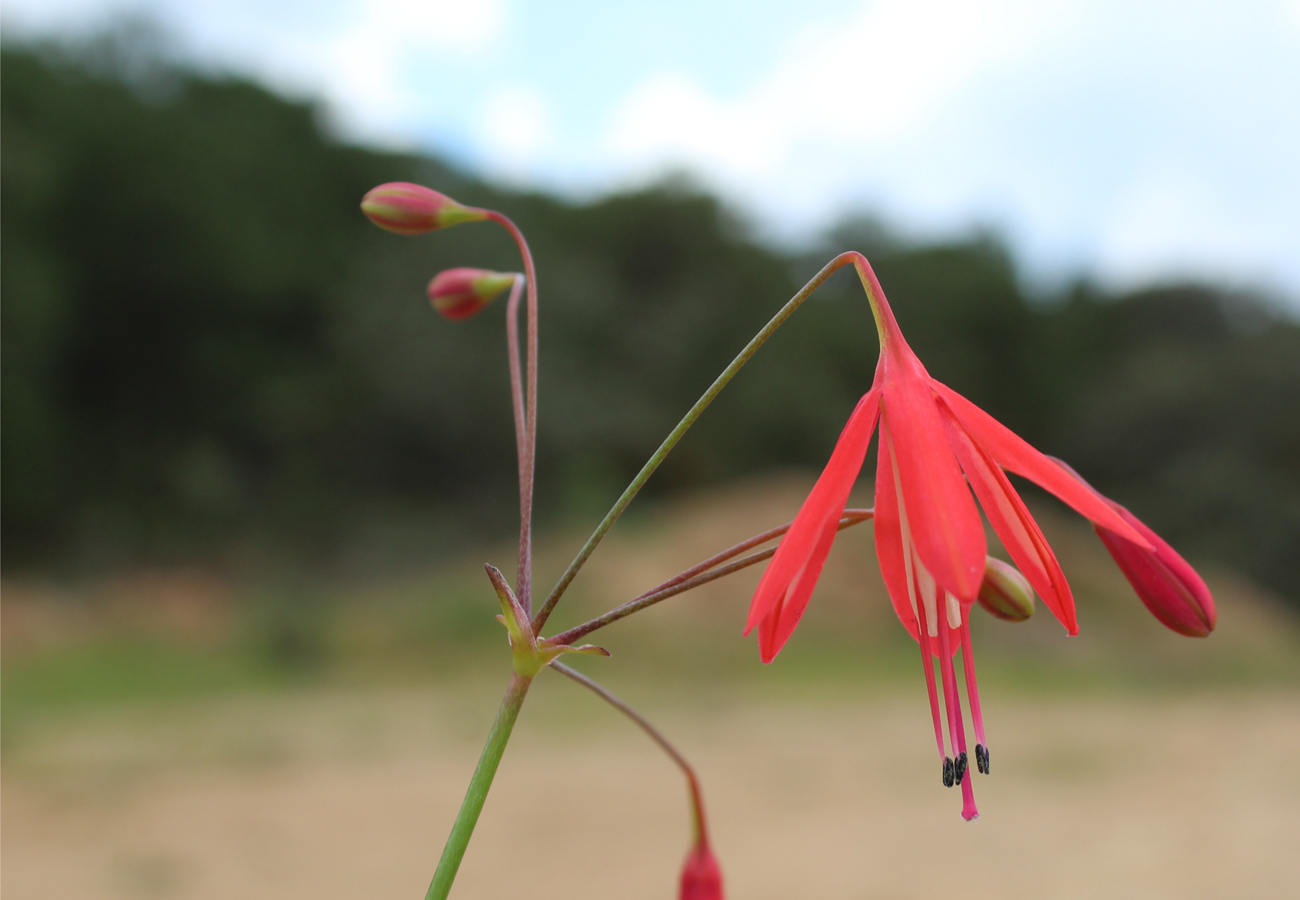Abstract
Bessera (Asparagaceae: Brodiaeoideae) is a genus endemic to Mexico. It currently has two described species: B. elegans with a wide geographic distribution from Durango and Sinaloa in the Sierra Madre Occidental, across the Transmexican Volcanic Belt to Oaxaca in the Sierra Madre del Sur, and B. tuitensis which is endemic to the Sierra del Cuale in Jalisco. Most of the morphological variation in Bessera occurs in western Mexico. We measured ten morphological characters for 280 plants from 21 populations, including B. tuitensis, to answer the following questions: Can Moore’s Group B of B. elegans be recognized as a different species? Are the newly included B. elegans s. l. populations from Colima different from B. elegans s. str., and from B. elegans s. l. (Moore’s group B)? Is there a significant relationship between morphological variation and climate variables for these species? The statistical analyses (ANOVA, MANOVA, and discriminant analysis) allowed us to recognize two new Bessera species, described here as B. elegantissima and B. ramirezii. Additionally, we provide a morphological key for Bessera, illustrations, a distribution map, and photographs of all the species.
References
Cavanilles, J.S. (1793) Icones et descriptiones plantarum, quae aut sponte in Hispania crescunt. Volumen II. Lazaro Gayguer, Madrid, 83 pp.
Chase, M.W., Reveal, J.L. & Fay, M.F. (2009) A subfamilial classification for the expanded asparagalean families Amaryllidaceae, Asparagaceae and Xanthorrhoeaceae. Botanical Journal of the Linnean Society 161: 132–136. https://doi.org/10.1111/j.1095-8339.2009.00999.x
Fay, M.F. & Chase, M.W. (1996) Resurrection of Themidaceae for the Brodiaea alliance, and recircumscription of Alliaceae, Amaryllidaceae and Agapanthoideae. Taxon 45: 441–451. https://doi.org/10.2307/1224136
Fick, S.E. & Hijmans, R.J. (2017) WorldClim 2: new 1km spatial resolution climate surfaces for global land areas. International Journal of Climatology 37: 4302–4315. https://doi.org/10.1002/joc.5086
Gándara, E., Sosa, V. & León de la Luz, J.L. (2009) Morphological and molecular evidence in the delimitation of Behria and Bessera, two genera in the Milla complex (Themidaceae). Boletín de la Sociedad Botánica de México 85: 113–124. https://doi.org/10.17129/botsci.2309
Gándara, E., Specht, C.D. & Sosa, V. (2014) Origin and diversification of the Milla Clade (Brodiaeoideae, Asparagaceae): a Neotropical group of six geophytic genera. Molecular Phylogenetics and Evolution 95: 118–125. https://doi.org/10.1016/j.ympev.2014.02.014
Greene, E.L. (1886) Studies in the botany of California and parts adjacent. V—1. Some genera which have been confused with the name Brodiaea. Bulletin of the California Academy of Sciences 2: 125–144.
Gutiérrez, J., Salgado, D., Grego-Valencia & Terrazas, T. (2015) Morfología y anatomía foliar de los géneros del complejo Milla (Themidaceae). Revista Mexicana de Biodiversidad 86: 652–660. https://doi.org/10.1016/j.rmb.2015.06.008
Gutiérrez, J., Terrazas, T., Hernández-Sandoval, L. & Martínez-Cabrera, D. (2010) Anatomía floral de los géneros del complejo Milla (Themidaceae). Boletín de la Sociedad Botánica de México 87: 1–12. https://doi.org/10.17129/botsci.287
Gutiérrez, J., Terrazas, T., Luna-Vega, I. & Salazar, G. (2017) Phylogenetic analyses of the Milla complex (Brodiaeoideae: Asparagaceae), with emphasis on Milla. Botanical Journal of the Linnean Society 185: 445–462. https://doi.org/10.1093/botlinnean/box074
Gutiérrez, J. & Terrazas, T. (2020) Xochiquetzallia (Asparagaceae, Brodiaeoideae), a new genus segregated from the paraphyletic Dandya. PhytoKeys 139: 39–49. https://doi.org/10.3897/phytokeys.139.46890
Hammer, Ø., Harper, D.A.T. & Ryan, P.D. (2001) PAST: Paleontological statistics software package for education and data analysis. Palaeontologia Electronica 4: 1–9.
Hoover, R.F. (1941) A systematic study of Triteleia. American Midland Naturalist 25: 73–100. https://doi.org/10.2307/2420844
Hoover, R.F. (1955) Further observations on Brodiaea and some related genera. Plant Life (Herbertia edition) 11: 13–23.
IUCN (2019) Guidelines for Using the IUCN Red List Categories and Criteria. Version 14. Standards and Petitions Committee, 113pp.
Kellogg, A. (1863) On a new plant of the Asphodel family, found by Dr. J.A. Veatch at New Idria and cultivated by Mr. H.G. Bloomer, botanical curator to the Academy. Proceedings of the California Academy of Natural Sciences 2: 11–12.
Kunth, C.S. (1843) Enumeratio plantarum omnium hucusque cognitarum secundum familias naturales disposita, adjectis characteribus, differentiis et synonymis. Vol. 4. Sumtibus J. G. Cottae, Stutgardiae et Tubingae, 752 pp. https://doi.org/10.5962/bhl.title.67381
Lindley, J. (1829) Edward’s Botanical Register XV. James Ridgway and Sons, Piccadilly, London, 272 pp.
Moore, H.E. (1951) Petronymphe, a new genus of Amaryllidaceae. Gentes Herbarum 8: 258–260.
Moore, H.E. (1953) The genus Milla (Amaryllidaceae-Allieae) and its allies. Gentes Herbarum 8: 262–294.
Pires, J.C. & Sytsma, K.J. (2002) A phylogenetic evaluation of a biosystematic framework: Brodiaea and related petaloid monocots (Themidaceae). American Journal of Botany 89: 1342–1359. https://doi.org/10.3732/ajb.89.8.1342.
Pires J.C., Fay, M.F., Davis, W.S., Hufford, L. Rova, J. Chase, M.W. & Sytsma, K.J. (2001) Molecular and morphological analyses of Themidaceae (Asparagales). Kew Bulletin 56: 601–626. https://doi.org/10.2307/4117686
QGIS Geographic Information System (2020) Open Source Geospatial Foundation Project. [https://qgis.org/en/site/]
Ramírez-Delgadillo, R. (1992) Una nueva especie de Bessera (Liliaceae) del Occidente de Jalisco, México. Boletín del Instituto de Botánica de la Universidad de Guadalajara 1: 131–136.
Rzedowski, J. (1978). Vegetación de México. Limusa, México, D. F. 432 pp.
Rzedowski, J. (1993) Diversity and origins of the phanerogamic flora of Mexico. In: Ramamoorthy, T.P. Bye, R., Lot, A. & Fa, J. (Eds.) Biological Diversity of Mexico: Origins and Distribution. Oxford University Press, New York, pp. 129–144.
Schultes, J.H. (1829) Bessera elegans. Genus novum Hexandriae Monogynieae. Linnaea 4: 121–127.
Smith, J.E. (1811) Characters of a new Liliaceous genus called Brodieae. Transactions of the Linnean Society of London 10: 1–5. https://doi.org/10.1111/j.1096-3642.1810.tb00010.x
Thiers, B. (2020) [continuously updated] Index Herbariorum: A global directory of public herbaria and associated staff. New York Botanical Garden’s Virtual Herbarium.
Turner, B.L. (1993) Jaimehintonia (Amaryllidaceae: Allieae), a new genus from northeastern Mexico. Novon 3: 86–88. https://doi.org/10.2307/3391431
Watson, S. (1885) Contribution to American Botany. Proceedings of the American Academy of Arts and Sciences 20: 324–378.
WorldClim (2020) Available from: https://www.worldclim.org/data/bioclim (accessed 29 September 2020)


